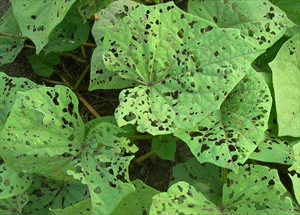Sweetpotato red leaf beetle, red sweetpotato beetle
Pacific Pests, Pathogens, Weeds & Pesticides - Online edition
Pacific Pests, Pathogens, Weeds & Pesticides
Sweetpotato red leaf beetle (053)
Candezea (Monolepta) species. There has been a recent revision of the genus, so previous records are now in doubt. However, Candezea palustris has been recorded from Solomon Islands.
It is recorded from Australia, New Caledonia, Solomon Islands, Papua New Guinea, and Vanuatu.
Sweetpotato and kangkong (Ipomoea aquatica), and related Ipomoea species (plants in the morning glory family). The beetle is seen commonly on other crops, but does not appear to feed on them.
Adult beetles (Photo 1) feed on leaves, chewing holes, especially in the middle of the leaf between the veins (Photos 2-4).
The biology and life cycle has not been studied for Candezea palustris. The following information is from a similar pest species in Australia (Monolepta australis).
Eggs are laid under the soil surface. The white cylindrical grubs or larvae feed on roots and pupate in the soil. The life cycle takes about 2 months. There may be three to four generations a year. If larval populations in the soil are high, the emerging beetles will form a swarm that migrates into crops nearby.
The impact is greatest to young plants and can delay establishment and early growth (Photo 5). Damage also occurs on flowers. The effect of the damage on storage root yields has not been determined. Probably, the impact is small as long as the plants recover from the initial attack after planting. There is also the possibility that Candezea damages the fine roots and stems and allows entry of other organisms, fungi and nematodes especially, but no studies have been done.
Look for red oval beetles, about 6 mm long, on the leaves and flying between them. They have a small black triangular spot at the base of the wing cases, and are black underneath. They are often seen in groups on young and old leaves. Look for numerous small holes in the leaves between the veins. Adults are strong fliers, and quickly take to the wing when disturbed.
The red pumpkin beetle, Aulacophora, is similar and often mistaken for Candezea. It has a groove across the base of the thorax - the part behind the head. By contrast, Candezea has a smooth thorax. Also, Aulacophora is larger than Candezea (see Fact Sheet no. 40).
There is little known about the natural control of the sweetpotato red leaf beetle. There are no known predators or parasites effective against high populations. The beetles contain chemicals that visual predators (birds and lizards) do not like, and they avoid them. The bright colours of this beetle warn predators that they are distasteful.
RESISTANT VARIETIES
None known, but fast-growing varieties are more likely to outgrow the damage caused by the beetles after planting. Look for differences in damage between varieties.
CULTURAL CONTROL
Before planting:
- Avoid planting new crops next to those already infested with the beetles
During growth:
- Provide conditions for healthy rapid plant growth, especially for cuttings; these may include manures, mulches, commercial fertilizers, as well as adequate water.
- In the early morning or evening, it is possible to catch the beetles in flight; this is a useful control method in small gardens. Perhaps a game for children!
After harvest:
- Collect and destroy the vines, before planting a new crop.
CHEMICAL CONTROL
- Ash may be effective against sweetpotato red leaf beetle. Apply to the crop as soon as the pest is seen; do not wait until the population is high. (See Fact Sheet no. 56).
- Alternatively, add ½ cup of wood ash and ½ cup of lime in 4 L water; leave to stand for some hours; strain; test on a few infested plants first to make adjustment to the strength before going into large-scale spraying.
- Use plant-derived products, such as derris, pyrethrum or chilli (with the addition of soap). (see Fact Sheet no. 56).
- Alternatively, synthetic pyrethroids are likely to be effective, but will also kill natural enemies.
- As infestations are often patchy, consider spot spraying or perimeter spraying where numbers are highest, leaving most of the crop unsprayed.
--------------------
Note, derris (Derris species) contains rotenone, an insecticide, often used as a fish poison; it should be used with caution. The commercial derris insecticide is made from Derris elliptica.
____________________
When using a pesticide (or biopesticides), always wear protective clothing and follow the instructions on the product label, such as dosage, timing of application, and pre-harvest interval. Recommendations will vary with the crop and system of cultivation. Expert advice on the most appropriate pesticide to use should always be sought from local agricultural authorities.
AUTHORS Helen Tsatsia & Grahame Jackson
Information from Chris Reid (pers.comm.), Australian Museum, Sydney; and Business Queensland (2019) Leaf beetles in field crops. Queensland Government. (https://www.business.qld.gov.au/industries/farms-fishing-forestry/agriculture/crop-growing/pests-field-crops/leaf-beetles); and from DAF (2017) Red-shouldered leaf beetle. Queensland Government. (https://www.daf.qld.gov.au/business-priorities/agriculture/plants/fruit-vegetable/insect-pests/red-shouldered-leaf-beetle).
Produced with support from the Australian Centre for International Agricultural Research under project PC/2010/090: Strengthening integrated crop management research in the Pacific Islands in support of sustainable intensification of high-value crop production, implemented by the University of Queensland and the Secretariat of the Pacific Community.








